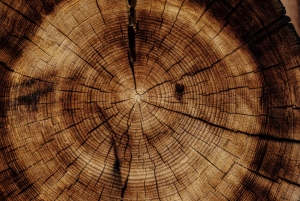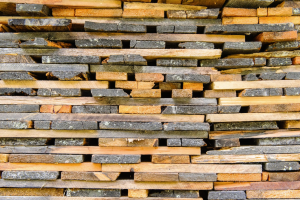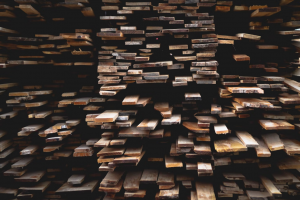Have you ever wondered how hardwood floors are made? It’s a process that involves a lot of careful craftsmanship and engineering.
In this blog post, we will take a look at the process of making hardwood floors and find out what goes into making them so strong and beautiful. Stay tuned!
It All Starts From Trees
The first step in making hardwood floors is to obtain the wood from trees. The most common type of wood used for hardwood floors is oak, although many other types of wood are used as well.
Transportation to The Sawmill

Imagine you’re standing in a forest. All around you are trees of all sizes, shapes, and colors. The air is fresh, and the sun is shining through the leaves. Suddenly, you hear a sound in the distance. As it gets closer, you realize it’s a sawmill. The sawmill is where logs are brought to be cut into lumber for hardwood floors.
Remove The Bark
After the wood arrives at the sawmill, the logs are debarked, which means the bark is removed. The bark is removed so that only the smooth wood beneath is left. First, it helps to prevent damage to the saw blades. Second, it makes it easier to transport the logs through the rest of the mill.
Softer woods are usually used for the construction of furniture while harder woods are used for flooring and other purposes where durability is important.
Drying The Wood

Before wood can be turned into beautiful hardwood floors, it must first be dried. This is a crucial step in the process, as wet wood is much more susceptible to damage and rot.
By drying the wood, builders can be sure that their floors will last for many years to come. The drying process also helps to bring out the natural grain of the wood, giving each plank its own unique character. The process of drying is done through a kiln, where the temperature and humidity are carefully controlled.
However, drying wood is not always easy. Depending on the type of wood and the climate, it can take weeks or even a month to achieve the perfect level of moisture. But in the end, it is always worth the wait. After all, there’s nothing quite like the beauty of a freshly installed hardwood floor.
Cutting The Wood Into Planks

Once the wood is dry, it is time to cut it into planks. This is done by a machine called a gang saw. The gang saw consists of a large frame with a series of rotating blades.
As the wood is fed through the saw, the blades cut it into planks of the desired thickness. The planks are then sorted according to their width and length. The thicker the plank, the more expensive it will be. The wider the plank, the more it will cost. This is because it is more difficult to find wide planks of wood.
The exact dimensions of the boards will depend on the type of wood and the desired final product. For example, thinner boards are typically used for flooring, while thicker boards are used for furniture or construction lumber.
The cutting process is usually done by large industrial saws, although some smaller mills still use hand-powered saws. Regardless of the type of saw used, the goal is always to produce high-quality boards that can be used in a variety of applications.
Get Rid of Defects
After the boards are cut, they are then inspected for defects. Defects can include things like knots, cracks, or other blemishes in the wood. The boards with the fewest defects are set aside to be used for high-end products like hardwood floors.
The boards with more defects are often used for cheaper products like particle board or construction lumber. However, even these boards can be used to create beautiful hardwood floors. It all depends on the desired final product.
Molding The Planks
After the boards are cut and inspected, they are then sent to a molder. The molder is a machine that shapes the boards into the desired shape. For example, many hardwood floors are made with tongue-and-groove planks.
This means that each plank has a small groove cut into one edge and a small tongue cut into the other edge. The tongues and grooves fit together like a puzzle, allowing the planks to interlock. This system makes it easy to install hardwood floors without any gaps or spaces between the boards.
Sanding
After the boards are molded, they are then sent to a sander. The sander is a machine that smooths out the surface of the wood. This gives the boards a nice, even finish that is perfect for hardwood floors.
The sander also removes any rough edges or splinters from the boards. This is important because it makes the boards safer to handle and less likely to damage the flooring during installation.
Sort By Color & Grade

After the boards are sanded, they are then sorted by color and grade. The grade is a measure of the board’s quality. The higher the grade, the better the quality.
For example, a first-grade board will be free of defects and have a consistent color. A third-grade board, on the other hand, may have more defects and be less consistent in color.
The grade of the board will affect its price. Higher-grade boards are more expensive, but they are also more durable and easier to install.
Tongue & Groove Treatments
Once the boards are sorted by color and grade, they are then sent to a tongue-and-groove machine. This machine applies a small strip of wood to the tongue and groove of each board.
This strip is called a v-groove or an interlocking strip. It helps to keep the boards locked together, making it easier to install the flooring.
Final Checks
After the tongue-and-groove machine, the boards are then sent for a final inspection. This is to make sure that they meet all the necessary standards for hardwood floors.
Prefinishing
Once the boards pass inspection, they are then sent to be prefinished. Prefinishing is a process that applies a protective coating to the boards.
This coating helps to protect the boards from damage during installation and makes them easier to clean and maintain. It also gives the boards a nice, finished look.
Pack & Ship
After the boards are prefinished, they are then packed and shipped. This is usually done on pallets, which makes it easy to load and unload the boards. The process is now complete and the hardwood floors are ready to be installed!
Final Thoughts
As you can see, there is a lot that goes into making hardwood floors. It is a complex process that involves many different steps.
However, the end result is always worth it. Hardwood floors are beautiful, durable, and easy to maintain. They can add value to your home and make it look more stylish and inviting.
If you are in the surrounding Denver area and are interested in having hardwood floors installed in your home or business, we’re help to help. We service the entire state of Colorado.
Contact MacDonald Hardwoods today to get a quote for your unique needs!